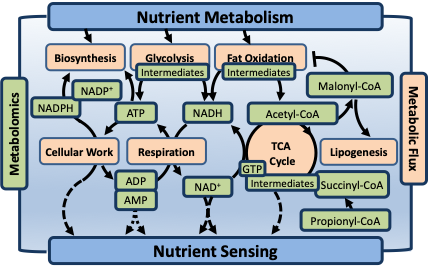Quantitative Metabolism and Imaging Core

Intermediary metabolism is dysregulated by many obesity-related diseases. The goal of the Quantitative Metabolism and Imaging Core is to equip NORC investigators with tools to interrogate these mechanisms. This core offers expertise in targeted metabolomics, tracer approaches, and metabolic flux analysis. Core personnel have experience using these approaches to interrogate substrate and TCA cycle metabolism, biosynthesis, tissue energetics, and redox factors. Core personnel will help NORC investigators pair the appropriate analytical and computational tools to their biological questions. Analytical platforms used by the Core include nuclear magnetic resonance (NMR), GC/MS, LC/MS/MS, and high-resolution orbitraps.
Description of Services
- Quantification of intermediary metabolites and cofactors
Targeted metabolomic data is often the first line of investigation before intensive tracer experiments are performed and helps to inform the design of those experiments by identifying target pathways.- Organic acids.
Lactate, pyruvate, TCA cycle intermediates (e.g., citrate, α-ketoglutarate, succinate, fumarate, malate, and oxaloacetate) are quantified by GC/MS or LC/MS/MS. - Amino acids.
Most nonessential and essential amino acids are quantified by LC/MS/MS. - Acylcarnitines.
C2-C18 acylcarnitines are quantified by LC/MS/MS. - Nucleotides and short chain acyl-CoAs.
Adenosine nucleotides (e.g., AMP, ADP, and ATP), nicotinamide adenine dinucleotides (e.g., NAD+ and NADH) and short-chain acyl-CoAs (e.g., acetyl-CoA, malonyl-CoA, succinyl-CoA, and propionyl-CoA) are quantified by LC/MS/MS.
- Organic acids.
- Tracer analysis
When changes in metabolite profiles or other data indicate a pathway of interest, Core personnel can advise users on appropriate tracer approaches to test their hypothesis and help analyze samples.- Tracer enhanced metabolomics.
This modified targeted metabolomics approach involves 13C-substrate administration and subsequent metabolomic analysis of tissue and/or plasma for the concentrations and 13C enrichment of metabolites. These results can provide semiquantitative insight into pathway connectivity but require less intensive analysis than quantitative flux approaches. - Rates of Whole-Body Metabolite Turnover.
The rate of appearance and disposal of a circulating metabolite can improve insight compared to static concentrations. Users will be advised on the infusion of stable isotope labeled metabolites. The Core will evaluate steady-state enrichment of the metabolite of interest, and turnover rates will be determined. For example, this approach is routinely used to measure endogenous glucose production in humans and animal models but can be generalized to many other metabolites. - Sources and Rates of Biosynthesis.
Deuterated water is an excellent tracer for measuring biosynthetic rates because it rapidly and completely distributes in body water, can be administered orally, maintains constant precursor enrichment, and incorporates into a large variety of biomolecules with high efficiency. Common applications include sources of endogenous glucose production, fractional lipid synthesis, and protein synthesis. - Metabolic Flux Analysis.
Certain pathways can be examined by following discrete carbon transitions that occur during biochemical reactions using a carbon-13 isotopomer analysis approach. This approach can be used to measure the oxidation of specific substrates, their metabolism in the TCA cycle, and can be generalized to any pathway with well understood biochemical transitions. These experiments require intensive experimental design, data analysis, and computational approaches.
- Tracer enhanced metabolomics.
- Isolated Perfused Liver.
Mouse livers are perfused via the portal vein with media containing substrates, hormones, and tracers. Mass balance analysis can be performed to evaluate hepatic glucose production, ketone production, oxygen consumption, triglyceride, or customized analytes. These protocols are commonly paired with one or more of the quantitative approaches described above. - Imaging
Core personnel have experience pairing metabolism studies with protocols to image hepatic lipids, liver volume, intramyocellular lipids, dual-energy X-ray absorptiometry, and 13C MRS and metabolism of HP substrates in vivo. In most cases, these imaging services can be obtained directly through the UT Southwestern Advanced Imaging Research Center (https://www.utsouthwestern.edu/departments/airc/), but in some cases, it may be useful to coordinate tracer administration, sample collection, and imaging protocols. - Training and Education
Core personnel will consult with users to help determine the best approach for their project. After initialization of a project, Core personnel will instruct users in the appropriate methodology for administering tracers, collecting tissue, and preparing samples for analysis. After sample analysis, users will be provided with data interpretation.
Program Director

Professor
Center for Human Nutrition and Department of Pharmacology

